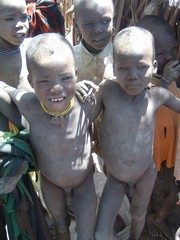Uganda : New crops for a vanishing people
Sept 6, 2005 (Timu, Karamoja) — On the mountaintop overlooking the great East African Rift Valley, in the remote dense forest of Timu in northeastern Uganda’s Karamoja region, live the Ik community, a tiny ethnic group threatened by hunger, and also by its neighbours.

There are, however, great difficulties for these hunter-gatherers and beekeepers in trying to adapt to a new agricultural way of life.
The banana plant, which is alien to the region, is grown in patches of pilot gardens on the mountain. Along with the hybrid tomato, it seems to be doing well in a community accustomed to living on wild plants.
Cut off from the outside world and totally devoid of common means of communication like telephones, the road to Timu – some 700 km northeast of the Ugandan capital, Kampala – is the single most important communication conduit for the community. It is a dirt track meandering through thickets that are home to the peaceful community.
Only 4,000 Ik people remain; living in fear of extinction for what they call their unique identity, language and culture – which has distinct Roman Catholic influences.
They live amidst threats from communities of herders nearby whose culture and way of life differ from theirs, such as the Dodoth of Uganda and Turkana of Kenya. These have forced the Ik to push further up onto the hills as a security mechanism.
“We are encouraging them to diversify and not depend only on the traditional sorghum. We have distributed seeds to them and banana stems so as to introduce new food-crops in the community,” Catherine Operemo, a field officer of the UN World Food Programme (WFP), said.
She said the WFP programme had become popular with women’s groups after the locals saw the results in the pilot gardens. Several had contacted WFP for more seeds and a similar effort in their localities.
BASIC FACILITIES
The community has just two primary schools and not a single secondary school. Until recently, it had no medical facilities.
Recently, WFP and Oxfam involved the locals in a self-help project, constructing a health centre. It is yet to be equipped, but is expected to reduce the 30-km distance that the locals to trek to the nearest medical facility.
“We had problems but we did not have the capacity to solve them. WFP encouraged people by giving food for the building material mobilised from the community and they bought the roofing material,” said Paulino Ngoga, an Ik elder who heads the projects management committee of the centre.
“Oxfam helped us by buying some of the material we could not get locally to build both the health centre and the grinding mill house,” he added.
He said the locals would now be able to store some of the excess food for food security, but also to sell some to other communities.
Timu remains relatively green throughout the year, which favours food sufficiency but also attracts more enemies for the Ik, as other communities tend to raid them for food.
“They have given up on cultivation of food as it attracted enemies, which has unfortunately rendered the community reliant on food relief. But even then, other tribes way-laid them and took away the food until trucks started food distributions right on the hill tops,” a relief worker in the area explained.
Ik elders said diseases, particularly malaria, had taken a harsh toll on their community, and in 1980, hundreds were killed in a cholera epidemic, after which many youth left to seek jobs across the border in Kenya.
They decried what they described as their abandonment by the Ugandan authorities. They appealed for government support, especially in the education of their children, as they believed an educated community could preserve the Ik culture.
“We want to maintain our culture. We want our children to be taught to write about our culture so that we can maintain our language,” Thomas Chilla, another elder, told reporters in Kamion, a tiny hamlet where the borders of Uganda, Kenya and Sudan meet.
“We need government protection,”Ngoga said. “We need government support in education.”
According to the elders, only four Iks have ever attended high school and none of them are employed. They said they knew of only one Ik in Uganda who held a paying job, but said he resided in the town of Gulu, further southwest of Timu.
The Ik say they migrated to the area over 200 years ago from Ethiopia and their ancestors settled in the highlands of Timu, with clans headed by a leader called “Jakhan Awae”, a title ascended to through inheritance.
IRIN/ST.
